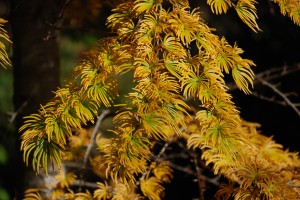Golden larch (Pseudolarix amabilis) is a rare find in U.S. landscapes. This deciduous conifer is native to eastern China. It is not a true larch (Larix spp.) and is relatively under-planted in the U.S. Golden larch appears to prosper in warm humid areas and should flourish in the southeast U.S. (USDA hardiness zone 6).
Golden larch may be planted in full sun to light shade. It thrives in organically rich moist soils which are well drained. A mature tree grows 50 to 60 feet in height and 30 to 40 feet in spread. A new tree starts out slowly, and growth becomes more moderately paced after 2 years. Tree shape is weakly pyramidal with open horizontal branches.
New spring foliage is light green, turns medium green in summer, and golden yellow in early fall before dropping. Golden larch earns its name for its spectacular golden yellow autumn leaf color, which ages to orangey-brown before falling in mid-October. Fall needle retention time is short compared to other deciduous conifers as larch (Larix spp.), bald cypress (Taxodium spp.) and dawn redwood (Metasequoia glyptostroboides). Needles range from 1 ½ to 2 ½ inches in length and are slightly curved.
Cones are 2 to 3 inches in length, 1 ½ to 2 ½ inches wide, green during the summer, maturing to golden brown in autumn. Young trees exhibit a reddish brown bark which age to grayish brown with some ridges and furrows.
Golden larch ages to a large majestic tree. Utilize it as a specimen tree on large properties such as golf courses, public parks, and college campuses. Disease and pest problems are as rare as finding this tree in U.S. commerce. Availability is from a few specialty nurseries selling on-line.


 Posted in
Posted in 
